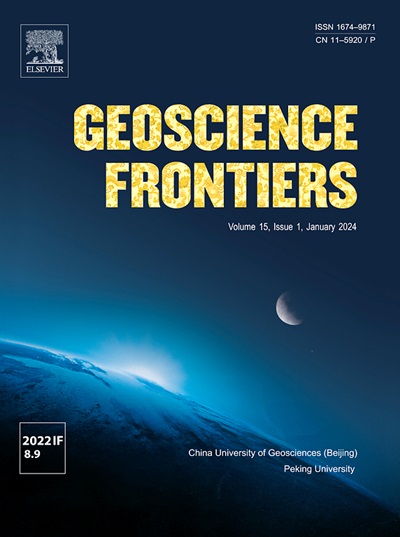Spatiotemporal analysis of AGB and BGB in China: Responses to climate change under SSP scenarios
IF 8.9
1区 地球科学
Q1 GEOSCIENCES, MULTIDISCIPLINARY
引用次数: 0
Abstract
Aboveground biomass (AGB) and belowground biomass (BGB) are key components of carbon storage, yet their responses to future climate changes remain poorly understood, particularly in China. Understanding these dynamics is essential for global carbon cycle modeling and ecosystem management. This study integrates field observations, machine learning, and multi-source remote sensing data to reconstruct the distributions of AGB and BGB in China from 2000 to 2020. Then CMIP6 was used to predict the distribution of China under three SSP scenarios (SSP1-1.9, SSP2-4.5, SSP5-8.5) from 2020 to 2100 to fill the existing knowledge gap. The predictive accuracy for AGB (R2 = 0.85) was significantly higher than for BGB (R2 = 0.48), likely due to the greater complexity of modeling belowground dynamics. NDVI (Normalized Difference Vegetation Index) and soil organic carbon density (SOC) were identified as the primary drivers of AGB and BGB changes. During 2000–2020, AGB in China remained stable at approximately 10.69 Pg C, while BGB was around 5.06 Pg C. Forest ecosystems contributed 88.52% of AGB and 43.83% of BGB. AGB showed a relatively slow annual increase, while BGB demonstrated a significant annual growth rate of approximately 37 Tg C yr−1. Under the low-emission scenario, both AGB and BGB show fluctuations and steady growth, particularly in South China and the northwestern part of Northeast China. Under the moderate-emission scenario, AGB and BGB show significant declines and increases, respectively. In the high-emission scenario, both AGB and BGB decline significantly, particularly in the southwestern and central regions. These results provide valuable insights into ecosystem carbon dynamics under climate change, emphasizing the relatively low responsiveness of AGB and BGB to climatic variability, and offering guidance for sustainable land use and management strategies.

中国AGB和BGB的时空分析:SSP情景下对气候变化的响应
地上生物量(AGB)和地下生物量(BGB)是碳储存的关键组成部分,但人们对它们对未来气候变化的反应仍然知之甚少,尤其是在中国。了解这些动态变化对于全球碳循环建模和生态系统管理至关重要。本研究整合了野外观测、机器学习和多源遥感数据,重建了2000年至2020年中国AGB和BGB的分布。然后,利用 CMIP6 预测了 2020 至 2100 年三种 SSP 情景(SSP1-1.9、SSP2-4.5、SSP5-8.5)下中国的 AGB 和 BGB 分布,以填补现有知识空白。AGB 的预测精度(R2 = 0.85)明显高于 BGB(R2 = 0.48),这可能是由于地下动态建模更为复杂。归一化差异植被指数(NDVI)和土壤有机碳密度(SOC)被认为是 AGB 和 BGB 变化的主要驱动因素。2000-2020 年间,中国的 AGB 保持稳定,约为 10.69 Pg C,而 BGB 约为 5.06 Pg C,森林生态系统贡献了 88.52% 的 AGB 和 43.83% 的 BGB。AGB 的年增长率相对缓慢,而 BGB 的年增长率显著,约为 37 Tg C/yr-1。在低排放情景下,AGB 和 BGB 均呈现波动和稳定增长,尤其是在华南和东北西北地区。在中度排放情景下,AGB 和 BGB 分别显著下降和上升。在高排放情景下,AGB 和 BGB 都显著下降,尤其是在西南和中部地区。这些结果为气候变化下的生态系统碳动态提供了宝贵的见解,强调了AGB和BGB对气候变异的响应性相对较低,为可持续土地利用和管理策略提供了指导。
本文章由计算机程序翻译,如有差异,请以英文原文为准。
求助全文
约1分钟内获得全文
求助全文
来源期刊

Geoscience frontiers
Earth and Planetary Sciences-General Earth and Planetary Sciences
CiteScore
17.80
自引率
3.40%
发文量
147
审稿时长
35 days
期刊介绍:
Geoscience Frontiers (GSF) is the Journal of China University of Geosciences (Beijing) and Peking University. It publishes peer-reviewed research articles and reviews in interdisciplinary fields of Earth and Planetary Sciences. GSF covers various research areas including petrology and geochemistry, lithospheric architecture and mantle dynamics, global tectonics, economic geology and fuel exploration, geophysics, stratigraphy and paleontology, environmental and engineering geology, astrogeology, and the nexus of resources-energy-emissions-climate under Sustainable Development Goals. The journal aims to bridge innovative, provocative, and challenging concepts and models in these fields, providing insights on correlations and evolution.
 求助内容:
求助内容: 应助结果提醒方式:
应助结果提醒方式:


